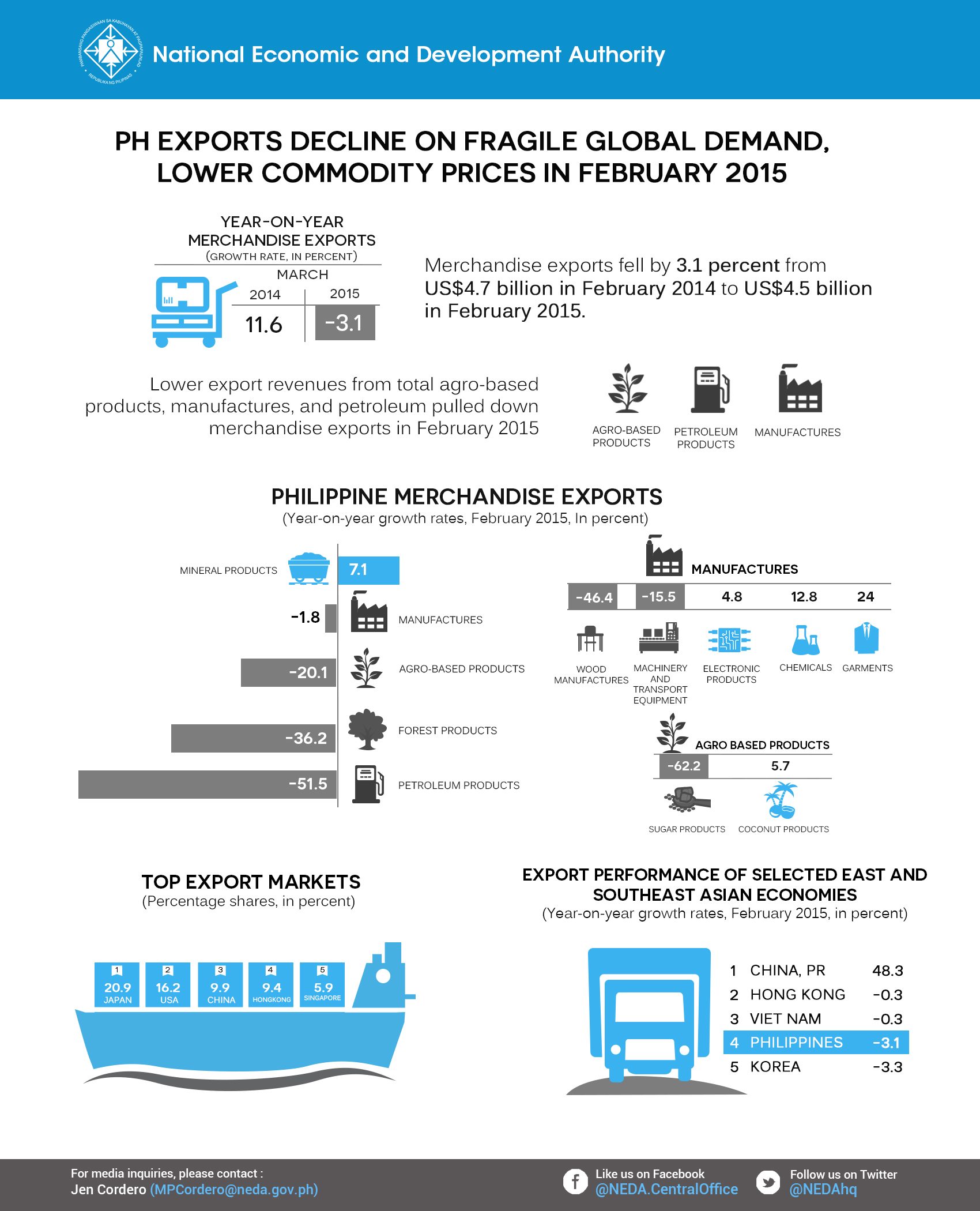SUMMARY
This is AI generated summarization, which may have errors. For context, always refer to the full article.

MANILA, Philippines (UPDATED) – Lower sales in agro-based products, manufactures, and petroleum products caused the fast decline of Philippine merchandise exports by 3.1% in February 2015, the National Economic and Development Authority reported Wednesday, April 8.
This is the third straight month that merchandise exports are recording contractions. Back-to-back declines were last seen in late 2011, analysts observed.
On an annual basis, exports have been steadily growing in the last 3 years. In 2014, exports rose 9%, setting a new record at $61.8 billion. In 2013, it registered an 8.8% growth and in 2012, a 7.9% growth.
The country’s merchandise exports reached $4.36 billion in January, a 0.5% drop from January 2014’s $4.38 billion growth, the Philippine Statistics Authority (PSA) reported Tuesday, March 10.
December’s merchandise exports also dropped 3.2% due to lower outbound shipments of manufactures, total agro-based, and petroleum products.
Why the decline?
For February this year, total revenue from Philippine exports reached $4.5 billion, down from $4.7 billion in the same period in 2014, the Philippine Statistics Authority (PSA) reported Wednesday.
Economic Planning Secretary Arsenio Balisacan said that it is not only the Philippines experiencing a negative export performance for February 2015, as majority of the major economies in East Asia and Southeast Asia also registered low export growth for the period.
Only the People’s Republic of China is in the positive, export performance-wise.
“This partly mirrors the still fragile global economy, which is particularly reflected in the country’s weak turnout of merchandise exports on the back of lower demand from the country’s major trade partners, Japan and China,” Balisacan said.
Particularly, agro-based products and manufactures are major commodity items that contributed to lower export outturn due to significant declines in shipments to Japan and China.
Total export revenues from agro-based products contracted by 20.1%, driven by lower earnings from fruits and vegetables, sugar products, and other agro-based products. This amounted to $327 million in February 2015, lower by 20.1% from $409.4 million in February 2014.
Earnings from exported manufactured goods also declined by 1.8%, recording $3.8 billion in February 2015 from $3.9 billion in February 2014. Lower receipts from wood manufactures, machinery and transport equipment, and other manufactures contributed to the decline.
The recorded contractions in these manufactured commodities slightly outweighed the year-on-year gains in the value of electronic products, most notably of semiconductors, garments, and chemicals, Balisacan said.
Electronic products exports grew by 4.8% in February 2015 to $1.97 billion from $1.88 billion in the same period last year, the Semiconductor and Electronics Industries in the Philippines Foundation, Incorporated (SEIPI) reported Wednesday.
Electronic products exports decreased by 3.4% from $2.04 billion in January to $1.97 billion in February since 9 electronic products sectors contracted, SEIPI said.
Also lower export volume and the plunging global prices of crude oil continue to drag revenues from petroleum products, which contracted by 51.5% during the period.
Mineral products, meanwhile posted a 7.1% increase in outward sales due to higher shipments of copper metal, gold, and iron ore agglomerates.
Japan remained as the top destination of Philippine-made goods accounting for 20.9% of total revenues from merchandise exports during the period.
The United States continues to be in the second spot with 16.2% share, and China with 9.9%.
Another slowdown?
Balisacan said that the February exports contraction was noted, but the forward estimates of manufacturing activity for both Japan and China suggests another slowdown for the country’s merchandise exports performance in March.
“Now is the high time to be vigilant,” he said.
Global commodity prices also continue to decline, potentially reducing revenues from agro-based and mineral exports in the succeeding period, Balisacan added.
Thus, the need to diligently monitor potential external shocks that can negatively affect the country’s trade performance, the economic czar said.
The government will also benefit from intensifying its efforts in expanding its market base for agro-based products.
Further improvements in infrastructure and logistics should also continue to support the export manufacturing sector, along with addressing the power supply concern for the summer months, he added. – Rappler.com
Add a comment
How does this make you feel?
There are no comments yet. Add your comment to start the conversation.